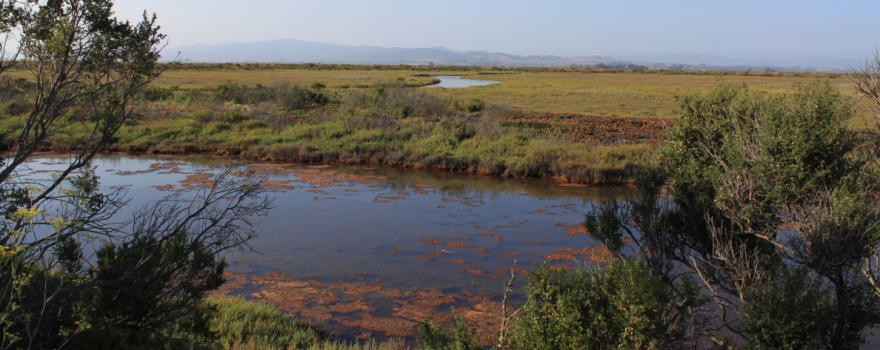Managing ecosystem restoration: what does success look like?
“Restoration projects are getting larger and more complex due to population growth, climate change, and disaster response. In the last decade alone, billions of dollars were spent to mitigate the effects of crises like Hurricane Sandy and restore habitats lost over centuries. As projects grow in size and complexity, so do the restoration costs. This underscores the need for a strategic approach to maximize both ecological and economic benefits. A national team of researchers, led by Pacific Northwest National Laboratory (PNNL), evaluated large-scale restoration efforts across the country and developed criteria, techniques, and tools to determine outcomes and ultimately, maximize benefits. This work was the focus of a study published in Frontiers in Ecology and the Environment. … ” Read more from Pacific Northwest National Laboratory here: Managing ecosystem restoration: what does success look like?
Fall, spring, and in between: new insights on the genetics of chinook migratory behavior
“The full diversity of life doesn’t fit neatly into categories, but that hasn’t dissuaded humans from trying to split animals into manageable groupings like species, often on the basis of differences in physical appearance or behaviors. For salmon, species are further divided into “runs” or “ecotypes” based on their migration timing. For example, the Chinook salmon (Oncorhynchus tshawytscha) that migrate back to freshwater earlier in the year and oversummer in rivers before spawning are labelled either “winter-run” or “spring-run,” whereas those that arrive in rivers after summer are deemed “fall-run” or “late-fall-run.” By examining the DNA of early and late arriving Chinook, scientists have made a remarkable discovery about the relationship between these two ecotypes, recently published in the journal Science (Thompson et al. 2020). As it turns out, they may not be as separate as historically believed, which may be good news for the recovery of imperiled Chinook populations. … ” Read more from FishBio here: Fall, spring, and in between: new insights on the genetics of chinook migratory behavior
Roly polies transfer environmental toxins to threatened fish populations in California
“Roly poly bugs may be a source of fun for kids and adults but these little bugs that form into balls at the slightest touch are causing problems for some threatened fish. New research finds steelhead trout in a stream on the California coast accumulate mercury in their bodies when the fish eat roly polies and similar terrestrial bugs that fall into local waterways. The new study corroborates earlier findings that mercury can make its way to the top of the food chain in coastal California. … ” Read more from Science Daily here: Roly polies transfer environmental toxins to threatened fish populations in California
Paiute cutthroat trout recovery effort continues despite the Slink Fire
“The Paiute cutthroat trout made national headlines last year when the Humboldt-Toiyabe National Forest, California Department of Fish and Wildlife, U.S. Fish and Wildlife Service and other partners returned this California native fish to its home waters in Alpine County for the first time in more than 100 years. The Paiute cutthroat trout was one of the first species in the nation listed under the federal Endangered Species Act in the 1960s. Recovery efforts continued this October when fisheries biologists relocated 44 Paiute cutthroat trout by pack animals from the nearby Corral Valley Creek into Silver King Creek, the fish’s historic home. Both creeks are in the Carson-Iceberg Wilderness on the Humboldt-Toiyabe National Forest. … ” Read more from the US FWS here: Paiute cutthroat trout recovery effort continues despite the Slink Fire
Ancient Alliance: Symbiotic relationship between California oaks and mutualist fungi appears to provide a buffer for climate change
““Happy families are all alike; each unhappy family is unhappy in its own way.” So goes the first line of Leo Tolstoy’s “Anna Karenina.” Little did the Russian novelist know his famous opening line would one day be used to describe microbial communities, their health and their relationships to their hosts. “It’s this idea that an unhealthy or stressed host to a microbiome has a more diverse microbiome than its healthy counterpart,” said UC Santa Barbara ecologist An Bui, a graduate student researcher in the lab of theoretical ecologist Holly Moeller. … ” Read more from UCSB here: Ancient Alliance: Symbiotic relationship between California oaks and mutualist fungi appears to provide a buffer for climate change
Beavers may help amphibians threatened by climate change
“The recovery of beavers may have beneficial consequences for amphibians because beaver dams can create the unique habitats that amphibians need. That finding was reported by four WSU Vancouver scientists in a paper published in the journal Freshwater Biology. The research took place in the Gifford Pinchot National Forest of the Cascade Range, where the researchers identified 49 study sites either with or without beaver dams. The researchers found the beaver-dammed sites were 2.7 times higher in amphibian species richness than the undammed sites. … ” Read more from Science Daily here: Beavers may help amphibians threatened by climate change
Scientists took a rare chance to prove we can quantify biodiversity by ‘testing the water’
“Organisms excrete DNA in their surroundings through metabolic waste, sloughed skin cells or gametes, and this genetic material is referred to as environmental DNA (eDNA). As eDNA can be collected directly from water, soil or air, and analysed using molecular tools with no need to capture the organisms themselves, this genetic information can be used to report biodiversity in bulk. For instance, the presence of many fish species can be identified simultaneously by sampling and sequencing eDNA from water, while avoiding harmful capture methods, such as netting, trapping or electrofishing, currently used for fish monitoring. … ” Read more from Science Daily here: Scientists took a rare chance to prove we can quantify biodiversity by ‘testing the water’
SCIENCE IN SHORT: Putting Nature, Not People, in the Path of Sea Level Rise
People, property, and nature all exist in the vulnerable zone of shoreline around the San Francisco Estuary that will soon be flooded by sea level rise. In this interview Julie Beagle, a lead climate scientist with the San Francisco Estuary Institute, discusses ways of defending our shores including several kinds of “nature-based” treatments that can delay and soften the onslaught, wave-absorbing “coarse beaches,” and adaptation planning focused on “operational landscape units.” Along the way, Beagle also describes how her own focus widened from natural systems alone to the people likely to be displaced by rising tides and other effects of climate change. “These are wicked scary problems,” she says.
About Science News and Reports: This weekly feature, posted every Thursday, is a collection of the latest scientific research and reports with a focus on relevant issues to the Delta and to California water, although other issues such as climate change are sometimes included. Do you have an item to be included here? Submissions of relevant research and other materials is welcome. Email Maven




